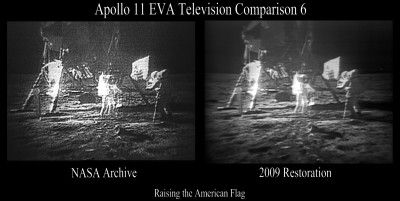From our front-page news:
Although GPGPU (general-purpose computing on GPUs) is growing in popularity, we're still a little ways away from it becoming totally mainstream, and used by many. Over the course of the past year, though, NVIDIA is one company who has actively been pushing GPGPU, along with their CUDA technology, in order to get applications and scenarios in front of consumers to show them the benefits that their speedy graphics cards can offer.
One area where GPGPU can drastically improve performance is with video encoding, especially where filters are concerned. In some cases, the performance can increase upwards of 100 times over a CPU, and it's for this reason that NVIDIA focuses on pushing the technology so hard. The company has just experienced a nice thumbs-up from a company called Lowry Digital, as well, as that company is the one which is responsible for enhancing the film footage of the Apollo 11 landing on the moon.
As you'd imagine, video footage from almost fifty years ago can't hold a candle to today's HD video, but even considering the time it was recorded, it still looks pretty bad given the circumstances. As you can see in the sample below, though, the image is drastically improved (there are more samples at the below link). In the press release, it notes that on typical CPUs, each frame being dealt with would take upwards of 45 minutes to process, but with GPGPU, it takes seconds.
Maybe this is the kind of news that NVIDIA and GPGPU as a whole needs to get consumers excited about such technology, especially given that many people don't realize they can do similar processing in their own homes.

“Lowry Digital’s restoration process has brought out details in the Apollo 11 videos that were never visible before,” said Andy Keane, general manager of the Tesla business unit at NVIDIA. “You can now see the faces of Neil Armstrong and Buzz Aldrin behind their visors, the stars on the U.S. flag when it is being raised and amazing details of the moon surface. We’re proud that NVIDIA has made such an important contribution to this historic project.”
Source: NVIDIA Press Release
One area where GPGPU can drastically improve performance is with video encoding, especially where filters are concerned. In some cases, the performance can increase upwards of 100 times over a CPU, and it's for this reason that NVIDIA focuses on pushing the technology so hard. The company has just experienced a nice thumbs-up from a company called Lowry Digital, as well, as that company is the one which is responsible for enhancing the film footage of the Apollo 11 landing on the moon.
As you'd imagine, video footage from almost fifty years ago can't hold a candle to today's HD video, but even considering the time it was recorded, it still looks pretty bad given the circumstances. As you can see in the sample below, though, the image is drastically improved (there are more samples at the below link). In the press release, it notes that on typical CPUs, each frame being dealt with would take upwards of 45 minutes to process, but with GPGPU, it takes seconds.
Maybe this is the kind of news that NVIDIA and GPGPU as a whole needs to get consumers excited about such technology, especially given that many people don't realize they can do similar processing in their own homes.

“Lowry Digital’s restoration process has brought out details in the Apollo 11 videos that were never visible before,” said Andy Keane, general manager of the Tesla business unit at NVIDIA. “You can now see the faces of Neil Armstrong and Buzz Aldrin behind their visors, the stars on the U.S. flag when it is being raised and amazing details of the moon surface. We’re proud that NVIDIA has made such an important contribution to this historic project.”
Source: NVIDIA Press Release
